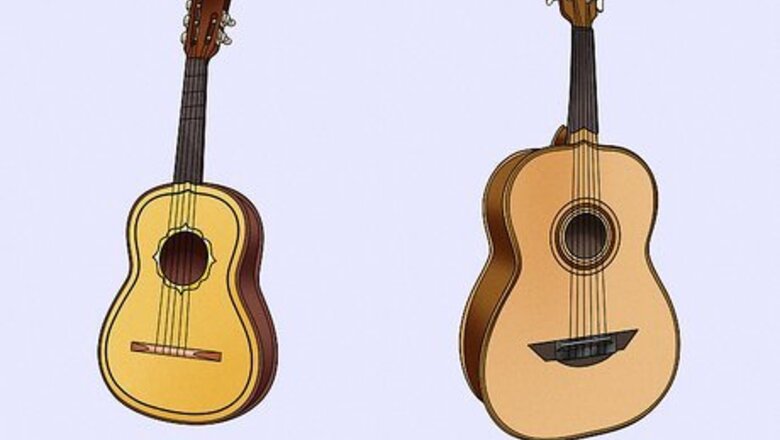
views
What guitar do you need to play Mexican guitar?
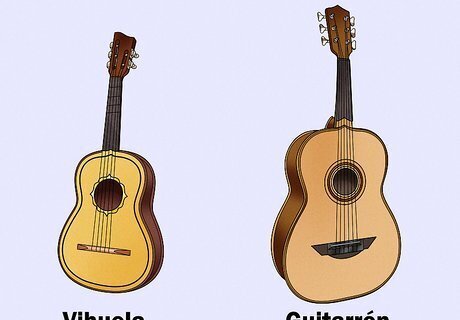
To play traditional Mexican guitar, buy a vihuela or guitarrón. Choose the guitarrón if you’d like to provide the bass in mariachi music, or choose the vihuela if you’re interested in a higher-pitched, smaller version of the guitarrón. Typically, you’ll play the guitarrón by plucking strings (like you would on a bass guitar), whereas you’ll strum a vihuela. Use a finger pick (that slides onto your index finger) to play the vihuela. The vihuela may be easier to pick up if you already play guitar because it has the same tuning as a normal guitar, without the bass E string. The guitarrón uses an entirely different tuning.
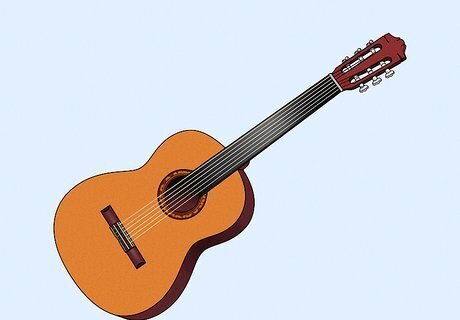
Alternatively, use a nylon-string or classical guitar. You’ll be able to learn the same strumming patterns and rhythms. Don’t use an acoustic, steel-string guitar. The stiffer strings will make it more difficult to learn fast picking and strumming. Use a thick plectrum (regular) pick to produce the strong, vibrant sound associated with mariachi.
How do you tune your guitar for mariachi music?

Your tuning will depend on the type of guitar you use. Tune your guitarrón strings to ADGCEA. Tune your guitar to standard EADGBE tuning. Tune the 5-string vihuela to ADGBE tuning, with the ADG strings one octave higher than on a standard guitar. Note that unlike a standard guitar, you’ll tune your guitarrón with ascending pitches until the sixth string, where you’ll tune down an octave. That means the notes (with octave notation) will be A1D2G2C3E3A2.
How do you hold a Mexican guitar?
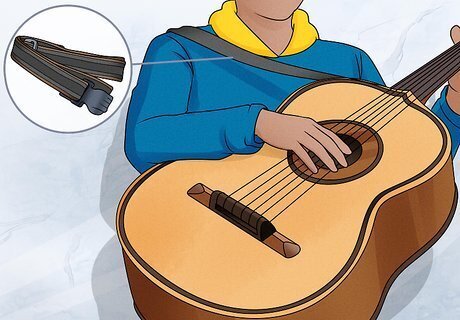
Use your knee or guitar strap to hold the guitar upright. If the guitar sits too low on your lap, try standing with your leg propped up on a stool. Your bent knee will act as a little shelf for the guitar to sit higher. If you’d like to stand without a stool, use a guitar strap at a length where your guitar feels most comfortable for you. No matter how you hold the guitar, be sure to stand or sit with good posture. To comfortably play your larger guitarrón, hold the body at an angle so that the face of the guitar is tipped towards you.
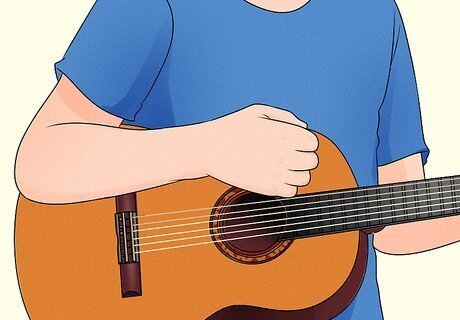
Use a relaxed right right arm and wrist. Relaxing your arm and wrist will help you strum quickly and produce the intense sound of mariachi music. Your wrist should be bent towards the strings. Don’t keep your arm straight, with your wrist parallel to the instrument. You can prop your right forearm on the lower bout of the guitar for stability.
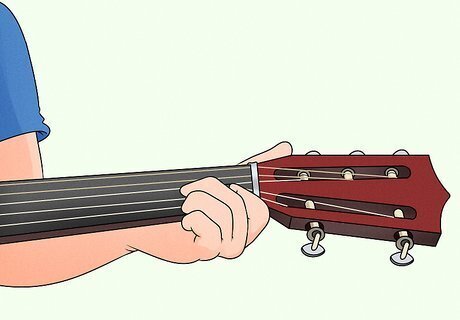
Hold your left hand around the neck of the guitar. Let your thumb wrap around the back of the guitar’s neck so you can use it to play bass notes.
What are the basic chords used in Mexican guitar music?
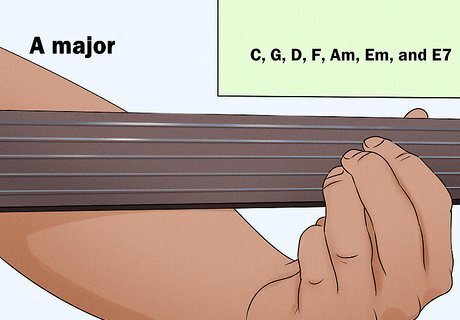
Mariachi music uses mostly open chords! You can stick to common shapes like C, G, D, F, Am, Em, and E7. You won’t need to worry about playing barre chords.
What songs can I learn on Mexican guitar?

Start by learning rancheras. Common mariachi song types (ranked from easy to hard difficulty) include rancheras, boleros, joropos, huapangos, and more. You can work your way up to learning huapangos, which are quite rhythmically difficult. You can find classic rancheras by singers like Vicente Fernandez, Los Tigres del Norte, and Marco Antonio Solis.
How do you play rancheras strumming patterns?
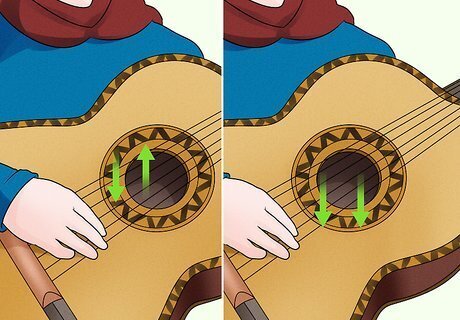
For rancheras, you’ll use basic down-up or down-down strumming. You’ll strum in 4/4 time (four beats) or 2/4 time (2 beats). Most of the time, you’ll play in response to the bass. For example, you’ll hear a bass note on beat one, and then you’ll strum on beat two. In basic down-up or down-down strumming, try to hit all the strings at once. Move your right hand, wrist, and arm in a smooth motion. Try to keep the downbeat and upbeat as evenly accented as possible. That means you’ll need to use equal force on the downstroke and upstroke so you don’t end up with one that’s louder. Because the tension on vihuela strings is higher (and you don’t use a plectrum pick), the vihuela requires a more forceful touch than the guitar or guitarrón. For down-down strumming patterns, keep your strums short so your hand doesn’t have as far to return on the upstroke. You can also play a 3/4 time version of a ranchera, called a ranchero or ranchera waltz. In a ranchera waltz, the guitarrón takes the first beat and the vihuela takes the other two beats within a measure.
How do you play boleros on guitar?
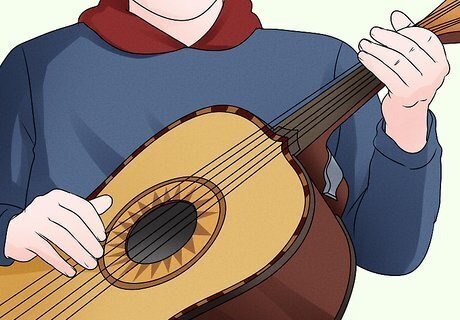
The bolero is a slightly faster rhythm. You’ll play boleros in 4/4 time (four beats per measure) with eighth note strumming (8 strumming strokes per measure). In a basic bolero, you can play down strokes for every beat. Boleros use circular chord patterns, so you’ll likely cycle through the same four chords over and over again.
How do you play a joropo strumming pattern?

To play joropo rhythms, you’ll incorporate muting. The joropo dance didn’t originate in Mexico, but its rhythms are commonly used in mariachi.To play a basic joropo rhythm, play two downstrokes and mute the guitar on the upstroke. The muting stroke is called an apagón. Create the mute by flattening your right hand knuckles against the strings to stop the resonance. Vary the joropo pattern by changing the beat of the mute. Try playing down-up-mute or mute-down-up instead of down-down-mute. On the vihuela, you’ll palm-mute the strings. Use an open hand to stop the strings from vibrating when you want to mute. Keep your thumb above the strings so you can quickly use it to strum again.
How do you play a huapango strumming pattern?
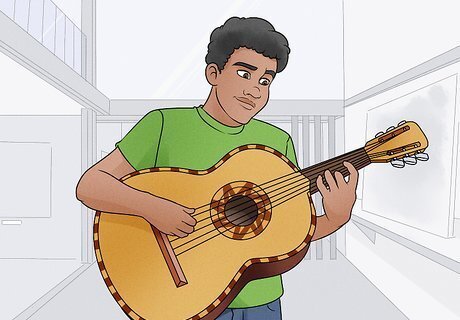
For huapangos, you’ll play a complex pattern in 3/4 time. The rhythm is 2 measures long (six beats total), so it’s best to start by learning the first measure. In the first measure, you’ll play a rhythm of one quarter note, followed by two eighth notes and another two eighth notes. Let’s break that first measure down into each individual beat: To play the first beat, make a single downstroke. To play the second beat, play a rasgueo (raking your fingers over the strings) followed by an apagón (muting the strings with your palm). For beat three, return to regular strumming with a down stroke and an up stroke. Note that a rasgueado or rasgueo is also called abanico or folding fan technique. To play a rasgueo, let all your right-hand fingers drag across the strings as you strum. Practice getting your fingers to fan out smoothly over the strings so that they hit evenly.

Break the second measure of the huapango into three beats. This time, you’ll incorporate sixteenth notes (which are twice as fast as eighth notes). First, you’ll play an eighth note apagón and two sixteenth notes using a down-down-up pattern. For beat two, you’ll play two eighth notes. You’ll play a down stroke apagón and then a regular down stroke. For beat three, you’ll play two eighth notes again with a simple down-up strum pattern.

















Comments
0 comment